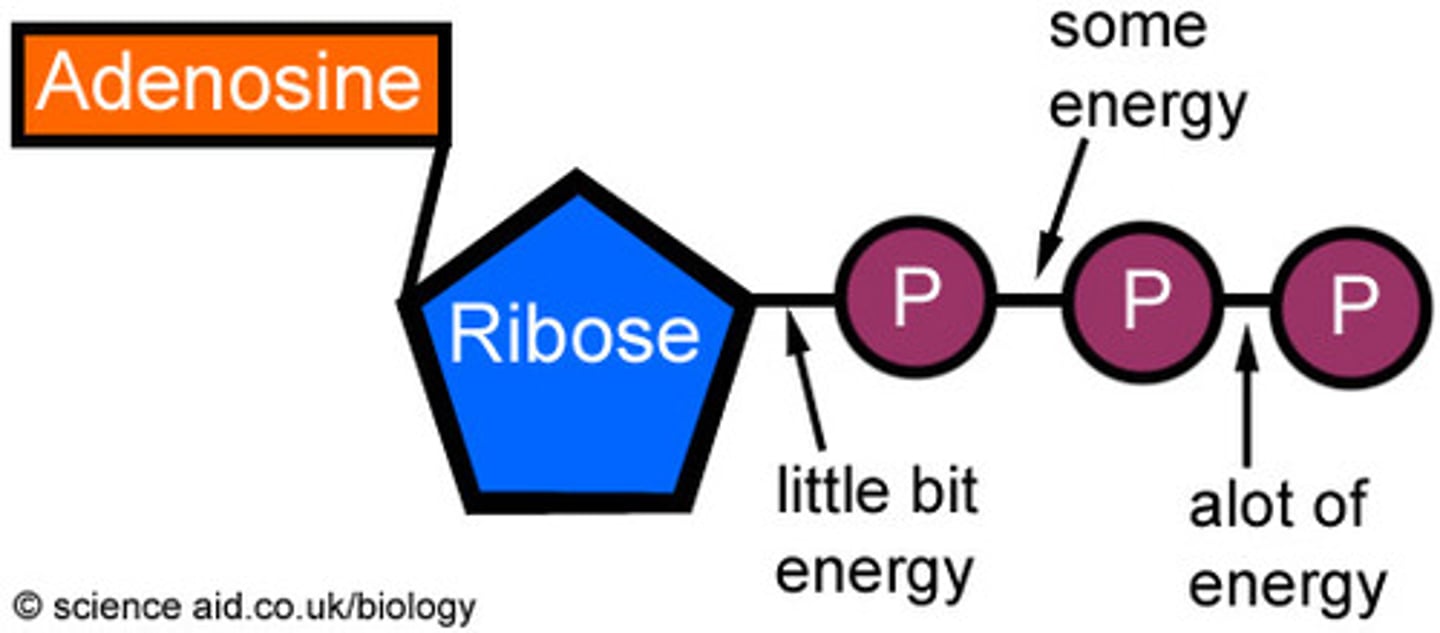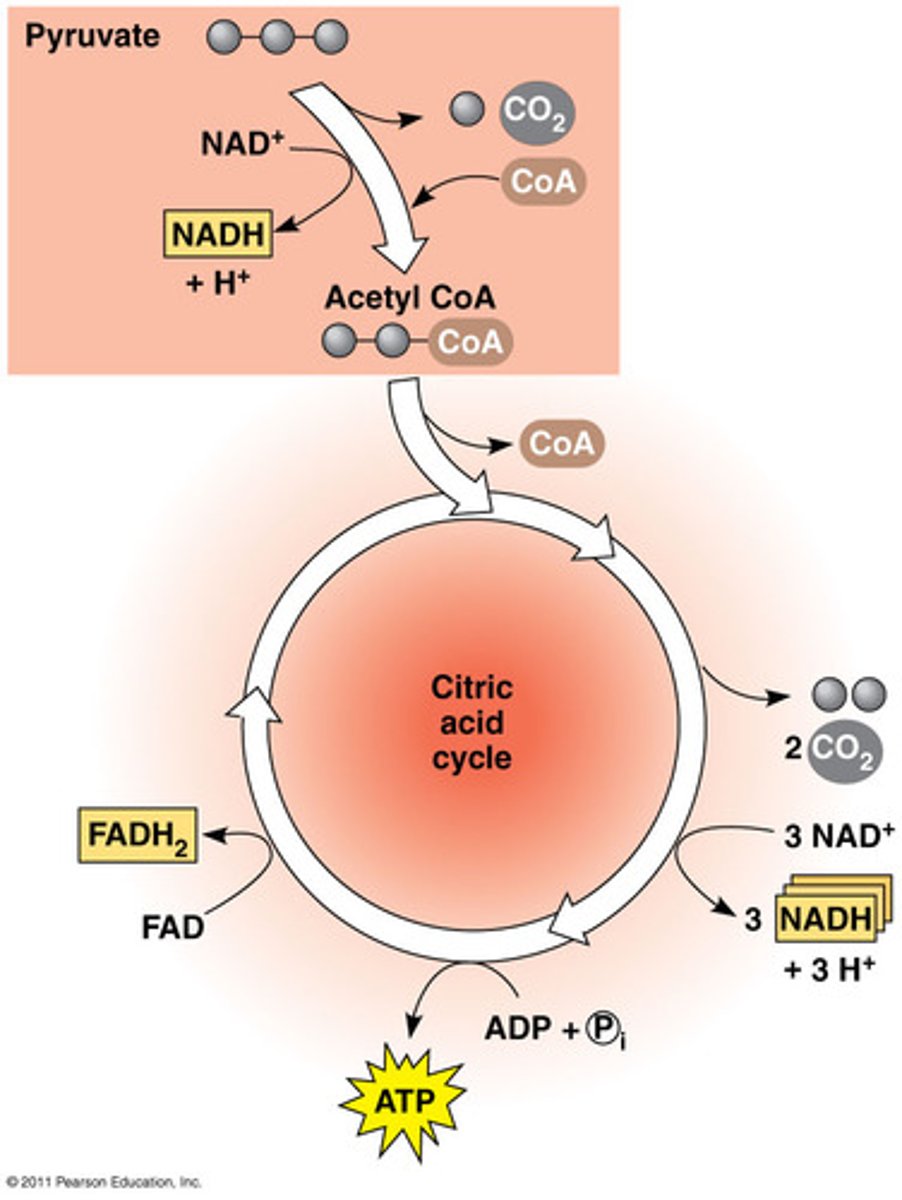Unit 3 Test Part 1 C1.3 - Cell Respiration pg. 361
1/44
There's no tags or description
Looks like no tags are added yet.
Name | Mastery | Learn | Test | Matching | Spaced |
|---|
No study sessions yet.
45 Terms
List 4 cellular processes that require ATP energy
cell respiration, condensation reactions, regeneration, and active transport of substances across membranes
Outline the structure of ATP
consists of a nitrogenous base called adenine, a five-carbon sugar molecule called ribose, and a chain of three phosphate groups attached to the ribose, with the key feature being the high-energy bonds between the phosphate groups, which release energy when broken during cellular processes; essentially acting as the cell's "energy currency"

What is ADP
a lower-energy molecule that can be converted into ATP by the addition of a phosphate group
What makes ATP a great energy currency?
1. Chemically stable @ cellular pH levels-Won't break down and release energy pre-maturely
2. soluble in water - diffuses freely and quickly thru cytoplasm 3. can't pass freely thru plasma membrane-movement between organelles is controlled and it can't exit the cell on its own
4. stores energy on the phosphate bonds-energy is efficiently used for many processes in cells
5. regenerated easily and efficiently-condensation and hydrolysis reactions can easily remove or re-attach the third phosphate group
What prevents a cell from running out of ATP?
This is prevented by continual regeneration of ATP from ADP and phosphate
oxidation
when a molecule loses electrons, typically by forming bonds to more electronegative atoms (more oxidized - less energy), gains O2, and loses H2
reduction
gain of electrons, loss of O2, gain of H2, (more reduced - more energy),
redox reactions
reaction in which 1 molecule is reduced and another is oxidized
cellular respiration
is the oxidation of carbs and fats to release energy, forming ATP for the cell

aerobic cell respiration
requires O2 for the complete breakdown of organic molecules. For every one molecule of glucose, 30-32 molecules of ATP are produced
anaerobic cell respiration
doesn't require O2 for the incomplete breakdown of organic molecules. For everyone of glucose, only 2 molecules of ATP are produced. Fermentation and glycolysis
lactic acid
a waste product of muscular anaerobic respiration --> the body can only tolerate so much so anaerobic respiration bouts are short & breaking it down requires O2 so the body is in O2 debt until its enough for the breakdown
what is oxygen debt?
the demand for oxygen that builds up during a
period of anaerobic respiration/intense exercise
electron carrier
substances that can accept and lose electrons reversibly, the electron carrier in cell respiration is NAD
glycolysis
In glycolysis, glucose is converted into pyruvate thru a series of reaction w/ a net production of 2 ATP. Occurs in cytoplasm and consists of 10 reaction split into 4 stages:
- phosphorylation
- Lysis
- oxidation
- ATP formation
glycolysis overview
One glucose, containing 6 carbons, is converted into two pyruvates, each containing 3 carbons. Two NAD molecules are converted to reduced NAD. Two ATPs are used in the first stage; four ATPs are produced in the last stage; this means that there is a net gain of two ATPs in glycolysis --> requires O2
Overview of Stage 1 - Phosphorylation
Glucose is converted into fructose-1,6-bisphosphate
over 3 reactions, This involves two phosphorylations and
therefore uses 2 ATPs:
1.Glucose to G6P
2.F6P to F-1,6-BP
Stage 1: Phosphorylation
Glucose is phosphorylated by one ATP molecule. Glucose-6-phosphate has higher energy and is relatively unstable; it will undergo more reactions to reach stability. Next, G6P will be converted to fructose-6-phosphate. Then, a second phosphorylation creates a symmetrical molecule (Fructose-1,6-bisphosphate).
Stage 2: Lysis
Fructose-1,6-biphosphate is split in half to produce two
molecules of triose phosphate
why is a symmetric starting molecule important
is crucial for the efficient and even splitting of the molecule into two three-carbon molecules EX: fructose-1,6-bisphosphate,
Overview of Stage 3 and 4
TP molecules are oxidized and reduce NAD to NADH + H⁺
TP oxidation produces glycerate, which gives phosphates to the TP molecules, transforming them into bisphosphoglycerates 4 ADP are phosphorylated to become ATP (the net ATP yield of glycolysis is 2!)
A few more reactions produce the final product of glycolysis:
pyruvate
Stage 3: Oxidation
The two triose phosphate molecules are oxidized when they each lose two H atoms; This produces 2 reduced NAD
molecules, As TPs are oxidized, they produce an organic acid called glycerate. Glycerate carries phosphate, which phosphorylates TPs; This results in production of 2 bisphosphoglycerates. Each biphosphoglycerate
has 2 phosphate groups
Stage 4: ATP Formation
The bisphosphoglycerates can phosphorylate 4 ADP
molecules total. This produces 4 total ATP molecules; as the final product of glycolysis, the 2 bisphosphoglycerates become 2 pyruvate molecules
Each biphosphoglycerate...
has 2 phosphate groups
What happens after glycolysis if there is no oxygen present?
the pyruvate produced will undergo a process called fermentation where it is converted into either lactic acid (in animals) or ethanol and carbon dioxide (in yeast)
What happens after glycolysis if there is oxygen present?
the pyruvate produced will enter the mitochondria and proceed through the Krebs cycle (also known as the citric acid cycle) followed by the electron transport chain, leading to oxidative phosphorylation
link reaction overview
The link reaction converts pyruvate into acetyl-CoA, releasing carbon dioxide and producing NADH. This process is crucial for preparing acetyl-CoA for the citric acid cycle, where it helps generate ATP and other energy carriers
link reaction (in depth)
The link reaction brings pyruvate into the mitochondrial
matrix & transforms it into acetyl coenzyme A (acetyl CoA):
1) Carrier proteins on mitomatrix bring pyruvate in
2) Pyruvate undergoes decarboxylation, releasing CO2
3) The resulting 2-carbon compound is oxidized
(H atom pair is removed), forming an acetyl group:
4) Acetyl compound combines with carrier coenzyme A
to form acetyl CoA, which begins the Krebs Cycle
krebs cycle overview
The Krebs cycle processes acetyl-CoA to produce energy carriers like NADH, FADH2, and ATP through decarboxylation, oxidation, and substrate-level phosphorylation. These reactions are essential for generating the electron carriers needed for the electron transport chain and ATP synthesis.

Kreb: decarboxylation layer
a carbon atom is removed from a molecule (such as citrate), releasing carbon dioxide (CO2), and NAD+ is involved in the process
Kreb: oxidation layer
the molecules like NADH and FADH2 are produced as NAD+ and FAD are reduced, with acetyl-CoA being oxidized
Kreb: phosphorylation layer
ATP is produced by adding a phosphate group to ADP using phosphate from organic molecules, and 2 ATP are produced per glucose molecule through two rounds of the cycle
Outline the location of glycolysis, the link reaction, the Krebs Cycle, and the ETC
Glycolysis occurs in the cytoplasm, the link reaction takes place in the mitochondria, the Krebs cycle happens in the mitochondrial matrix, and the electron transport chain (ETC) is located on the inner mitochondrial membrane
oxidative phosphorylation
part of electron transport chain, the energy stored within reduced H2 carriers (NADH, FADH) is released to synthesize ATP. Occurs in 3 steps: proton gradient generation, chemiosmosis, O2 as final electron acceptor @ first electron carrier
Provide a 1-4 sentence summary of the Electron Transport Chain step of aerobic cell respiration.
The electron transport chain (ETC) occurs on the inner mitochondrial membrane, where electrons from NADH and FADH2 are passed through protein complexes, creating a proton gradient that drives ATP synthesis. Oxygen is the final electron acceptor, forming water, and this process produces the majority of ATP in aerobic respiration
Explain what happens to generate a proton gradient
electrons from NADH and FADH2 are transferred through protein complexes in the electron transport chain, which use the energy released to pump protons (H+) from the mitochondrial matrix into the intermembrane space
Explain how that proton gradient is used to activate the ATP Synthase enzyme
proton gradient creates a higher concentration of protons in the intermembrane space, and as protons flow back into the matrix through ATP synthase, the energy from this flow activates the enzyme to synthesize ATP from ADP and inorganic phosphate
Explain oxygen's role as the final electron acceptor
Oxygen's role as the final electron acceptor is to combine with electrons and protons at the end of the electron transport chain, forming water and ensuring the continuation of electron flow by preventing backup in the chain
What is required to break down lactic acid?
O2 is required to break down lactic acid
What type of energy do we use to break down photolysis?
light energy
Is ATP soluble in water?
Yes
where do light reactions of photosynthesis take place?
chloroplast and thylakoid membrane
What types of respiration are part of metabolism that oxidize?
Anaerobic/aerobic respiration are both parts of metabolism that oxidize carbon compound to release energy as ATP
what is a product of anaerobic respiration
lactate/lactic acid
what is a product of aerobic respiration
ATP and CO2